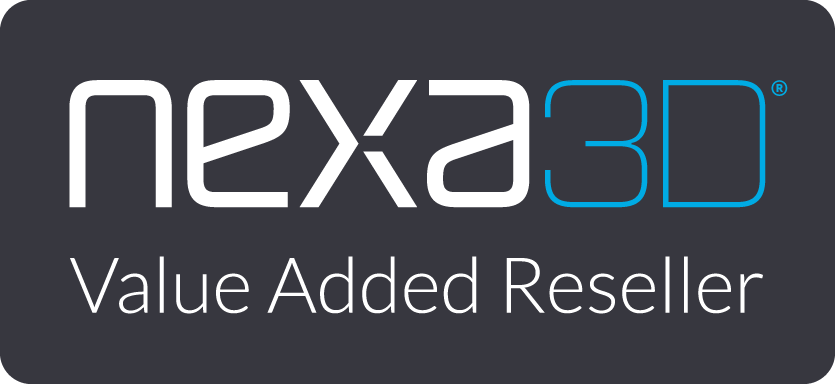Ultrafast 3D Printing – A Design Guide for LSPc Printing
XiP and NXE Series 3D Printers
Introduction
Learn more about the latest ultra-fast 3D printing materials in 2023. Which material can withstand the high heat and pressure required to produce 15,000 shots in a blow molding machine? Which resins are used for production parts that must withstand UV rays, changing temperatures and other elemental outdoor conditions? And this new ceramic material is the fastest 3D printing material, but it can also withstand the highest temperatures.
Want to know what other types of materials can be printed in minutes? Check out the guide.
This guide addresses:
- Updated materials for 2023
- Properties and possible applications of the materials
- Certified test specifications for each material
- Case studies on the use of materials



LSPc® technology
The Nexa3D process
Nexa3D’s proprietary LSPc technology converts photopolymer liquid resin into structural plastic using ultraviolet (UV) light. Advanced membrane technology combined with scalable 4K LCD image masking provides users with a highly productive manufacturing system that allows them to quickly iterate product concepts and then immediately move into production.
The intelligent NexaX software optimizes each shift for the shortest possible print times with consistent quality. Parts printed on XiP and NXE series 3D printers exhibit superior surface finish, full density, and isotropic properties unmatched by other additive manufacturing platforms.
Industries around the world are being enhanced by Nexa3D technology, including custom consumer products, dentistry, tooling, orthopedics, automotive, scientific research, electronics, leisure, entertainment and others. Professionals are leveraging the well-known benefits of additive manufacturing combined with the functional materials and productivity of the NXE 400 platform to create products that are revolutionizing the industry.
Ultra fast from Nexa3D
3D printing from desk to production in record time

| Volume | 4.8L 195 x 115 x 210mm (7.7 x 4.5 x 8.3 in) |
| Technology | LSPc |
| Pixel size | 52 µm (0.0020 in) |
| Maximum resolution | 4K (3840 x 2160) |
| 27 Part printing time* | 43 min |
| Printer footprint (xyz) | 420 x 350 x 530mm (16.5 x 14 x 21 in) |
| Material packing | 1kg aluminum cartridge |
*Calculated for a 3-way connection file with 200 micron layer height and x45 prototyping material.
Postprocessing
Automated washing and curing for XiP and NXE series 3D printers
Our post-processing solutions for 3D printing ensure consistent mechanical properties and predictable part performance for manufacturing with commercial 3D printers.
Xip
The XiP Wash + Cure is a 2-in-1 post processing station that provides optimal automated post-processing in a compact package. Simply drop parts into the wash bin with IPA or xCLEAN and run the wash cycle. Then remove the wash bin and place your part on the turntable, fold down the LED arm, and place the reflective cover over the top for post-curing.

General considerations
Thermal
Consider the overall process flow and physical constraints when designing for the LSPc process. Many of our design guidelines are similar to those of injection molding, as the resin undergoes a phase transformation and shrinkage of 1-2%, similar to a thermoplastic that solidifies in a mold. However, shrinkage occurs in layers, so abrupt changes in exposed cross-sections can cause deformation. We will give you tips on how to avoid this problem.
The curing of thick sections also leads to an increase in exothermic heat and some overcuring in the XY plane. NexaX 2.0 software optimizes print speed to control temperature. Adding fluidity to the liquid resin helps avoid thermal gradients in the part during build and allows for higher speeds.
Preparation of the construction
The first few layers of your build are intentionally overcured to ensure adhesion to the build plate and are slightly oversized in the XY direction. This should not be a problem, as generally only the supports are affected. If you are building without supports, add a 1-2 mm chamfer to the edges of the base surface. This allows the extruded features to remain dimensionally stable and easier to remove from the building panel. Each layer exaggerates the previous one by a certain percentage, so horizontal holes are somewhat oval if not compensated by 0.04 mm.
Postprocessing
Washing excess resin from the part can be difficult with blind holes, hollow chambers or microfluidic channels and requires advanced cleaning techniques. In addition, post-curing or baking may cause deformation of the flat plates. Add ribs or constrain the part during curing.
Postprocessing
Optical overcuring and through-curing
The resins used in photopolymer processes such as LSPc are not completely opaque, allowing light to penetrate through thin areas of the material and cause overcuring and/or through-curing. These effects are not problematic in most cases unless the parts are quite small or you are trying to achieve very tight tolerances with your design. If you understand these two phenomena, you can easily take them into account in your design and manufacturing.
Overlap (XY plane)
Overcuring occurs when the light from the UV light device is scattered beyond the edge of the mask and cures the material near the mask boundary, resulting in an additional 0.01-0.05 mm of cure beyond the mask boundary. The scatter is mainly caused by colorants and fillers in the resin, so that the correction factors vary depending on the material. Overhardening increases with exposure time and is usually more than 0.05 mm for the base layers.

Through-hardening (Z-axis)
Through-curing is an effect caused by the UV light from the alternator penetrating through the existing material layer and causing additional curing. This is necessary to achieve adhesion from layer to layer. Through-hardening leads to over-hardening of the material in the Z-axis. The depth of through-curing depends on the material, with high-resolution materials having through-curing in the range of 0.02-0.05 mm and some transparent materials having through-curing up to 1.0 mm.

Voxelization
Printed models are expressed as voxels with
- XY resolution = pixel size of the mask
- Z-Resolution = Layer Height
- Anti-aliasing is applied to XY edges by default
Design Consulting
- Design with building orientation in mind
- Use of surface textures and organic shapes
- Target feature size > 5 voxels.
Dealing with it
- Alignment orthogonal to the Cartesian Csys or at an angle greater than 10° to any axis.
- Decrease the slice height to minimize step formation or to achieve higher resolution in Z.

Design guidelines
Similar to injection molding or other 3D printing processes, it is important to keep the manufacturability of the product in mind. These design guidelines will help you produce the best possible parts and take advantage of the ultra-fast capabilities of the XiP and NXE series with LSPc® technology.
Table of contents
1 Wall thickness
2 Overhangs and bridges
3 Feathered edges
4 holes
5 Hollow and shell geometries
6 Threads, inserts and fasteners
7 Integration of text, engraving and embossing
1. wall thickness
Walls
Walls between 1-5 mm form reliably and withstand the forces of membrane separation and removal of supports. Walls with a thickness of 0.3 mm are possible with limited span and vertical alignment.
Walls thinner than 0.8 mm can be soaked during washing, so washing times are limited. When using support contacts, the wall thickness should be < 0.5 mm.
Thicker walls may prevent full post-cure and could become exothermic during printing, affecting part quality. Thick parts or walls > 25 mm can be printed at lower speeds to control temperature and shrinkage.

| Possible | |
|---|---|
| MIN wall freestanding | 0.5 mm |
| MIN wall with edge reinforcement | 0.3 mm |
Ribs
To maintain the shape during curing, an aspect ratio of 25:1 should be aimed at for large surfaces. In other words, a 1 mm thick wall should have stiffening ribs every 25 mm. The height of the ribs increases the effective wall thickness, so that a 1 mm high rib is used for a 50 mm span and a 3 mm high rib for a 100 mm span.

| Recommended | |
|---|---|
| Walls | 1-5 mm, uniform, aspect ratio 8:1 |
| Rib spacing | ~25:1 aspect ratio (i.e. for 1mm wall, one rib every 25 mm is recommended) |
2. overhangs and bridging
Horizontal overhang
A horizontal overhang is any part of the model that protrudes parallel to the build platform. These features are common and it is not recommended to print them without supports. Horizontal overhangs of more than 2 mm should be supported. If these overhangs are not supported, deformation is likely to occur.

Bridging
Horizontal surfaces bridged between walls or columns may span twice the distance as overhangs. This also applies to the influence radius of the supports (use an influence radius of 1.5 mm for horizontal surfaces at 0.1 mm). Spans of up to 20 mm can be printed with a loss of dimensional accuracy.

Angled overhang
An angled overhang is an overhang that extends in a direction other than parallel to the build platform. A minimum angle of 30° is required for these overhangs to be cantilevered. If the angle is less than 30°, supports must be used to ensure that the design prints as intended. Otherwise, there is a risk of delamination/detachment at these low angles.

| Recommended | Possible | |
|---|---|---|
| Horizontal overhangs | <2 mm | Up to 4 mm |
| Horizontal spans | <5 mm | <20 mm |
| Horizontal spans | >30 deg | >5 deg |
3. feathered edges
Rounded edges, also called knife edges, are features that taper down to zero.
A feathered edge should be blunted to 0.3 mm or more, otherwise there is a risk that it will be damaged and curl during finishing. Vibratory polishing requires further blunting.

| Recommended | Possible | |
|---|---|---|
| Dullness | >0.3 mm | >0.15 mm |
| Dullness for vibratory polishing applications | >1.5 mm | >1.0 mm |
4. holes
Minimum hole diameter
Holes with a diameter of less than 1.0 mm may close during printing due to through-hardening. Larger holes may be required for clear resins. Smaller holes are possible if they are aligned vertically. Cleaning holes can be a challenge. Avoid blind holes and holes with large aspect ratios. Cleaning with a pressure nozzle may be required to remove uncured resin from such holes.

Blind holes
The depth of blind holes is limited for holes less than 3 mm in diameter because surface tension prevents the resin from flowing off. Washing with a pressure jet, e.g. with a syringe, allows deeper holes. Add vents to the bottom of blind holes whenever possible.

| Recommended | Possible with special washing | |
|---|---|---|
| Vertical holes size | >0.8 mm | >0.3 mm |
| Non-vertical hole size | >1 mm (opaque resin) >2 mm (clear resin) |
>0.6 mm |
| Depth of the blind hole | <3x diameter | <8x diameter |
| Through hole length | <8x diameter | <25x diameter |
5. hollow and cupped geometries
Closed volumes
Drain holes are required when there is a closed volume, such as a hollowed-out part. The drain hole is used to flush the resin from the closed cavities of your model. Without drain holes, uncured resin would remain trapped in the part and possibly cause damage to the part. Use at least two 3 mm diameter holes to allow cleaning of the part, or at least 5 mm diameter if only one hole is possible. It is best to place the holes near corners where resin and solvent would flow naturally.

Venting and cupping
When a cupped feature is printed open to the vat, the resin is pulled up by the vacuum when the Z-axis is raised to separate, and the resin is pressurized when the axis returns to the platform. To avoid defects, you should install a vent at the base of the feature. NexaX allows the addition of tapered holes and matching plugs so that the hole can be patched after printing. The size of the hole should correspond to the size of the enclosed volume – a diameter of 10% of the volume span is usually sufficient.

6. threads, inserts and fastening
Thread
Large thread forms that are to be molded from plastic, such as bottle caps, are no problem for LSPc technology. The threads should be printed with the axis approximately perpendicular to the platform to avoid defects due to supports.
Machine threads intended for metal fasteners may be functional up to size M4 or US Series No.8, but through-hardening may affect the thread form and cause friction. If possible, re-tap machine thread forms after curing with a tap or die. These threads are not ideal for repeated fastenings.

Fastening with metal bolts and screws
When fastening with machine bolts and screws, it is recommended to use a metal insert such as a hex nut, a heat-age hardened insert or a spacer to avoid overstressing the plastic. Thermofixed inserts are best applied before curing. When using a thread-forming screw to screw into a thermoplastic, choose a tough material such as xABS or xPP, otherwise the screw may break the protrusion.

Push buttons
Snap connections should be designed for the material used. The snapper length, thickness and interference should keep the elongation below 50% of the material limit. With an elongation of about 85%, material grade xPP is well suited for snap-fit joints designed for molded polyamide.

| Column 1 | Column 2 | Column 3 |
|---|---|---|
| Column 1 Value | Column 2 Value | Column 3 Value |
7. integration of text, engraving and embossing
Text and other surface features may be embossed on or engraved into the primary part surface. Typical text height for most sans-serif fonts should be above 4 mm and use an emboss height or engrave depth equal to line width of the characters for best readability.
Avoid calligraphic or serif fonts for small text since they often include elements with narrow line width.
If using engraved text on the down-skin surface (facing the build plate), stay within the recommended size range, and use rounded or beveled edges. Islands (like the center of letter O) require support or should be filled in.


| Recommended | Possible | |
|---|---|---|
| Character height | >4 mm | >2.5 mm |
| Embossing height/engraving depth | >0.5 mm, or equal to the line width | >0.25 mm |
| Line width | >0.4 mm | >0.25 mm |
File and print preparation
After you have completed your design, it is important to prepare your file and build to take advantage of the best possible production speed and part quality.
Table of contents
1 Orientation and support
2 File preparation
3 Alignment and holder generation
4 Fit alignment, part spacing and uniformity in slices
5 Orientation – high aspect ratio management
6 Fine features and steps
1. orientation and support
When you lift the part off the platform on a scaffold support, you avoid the skirting caused by overcuring the base layer and decouple the part from the rigid build plate, allowing predictable shrinkage without residual stress.
Ensure that supports are present at all local minimum points, including text or texture features that are greater than the layer height.
If you are supporting large, low-angle or horizontal surfaces, use a higher support density, smaller cell size and smaller influence areas.
When supporting surfaces in the range of 30-60°, the default settings can be used. In general, the density can be reduced (the radius of influence increased) as the angle of the supported surface increases.
Place supports on surfaces from which they can be easily removed and sanded.
Avoid support on fixing surfaces or test points.
NexaX gives you the freedom to fully configure the support parameters and edit the positions and sizes of each contact point. If you are unsure which overlay strategy is best for your part, you can view multiple configurations within a single build to test them.



